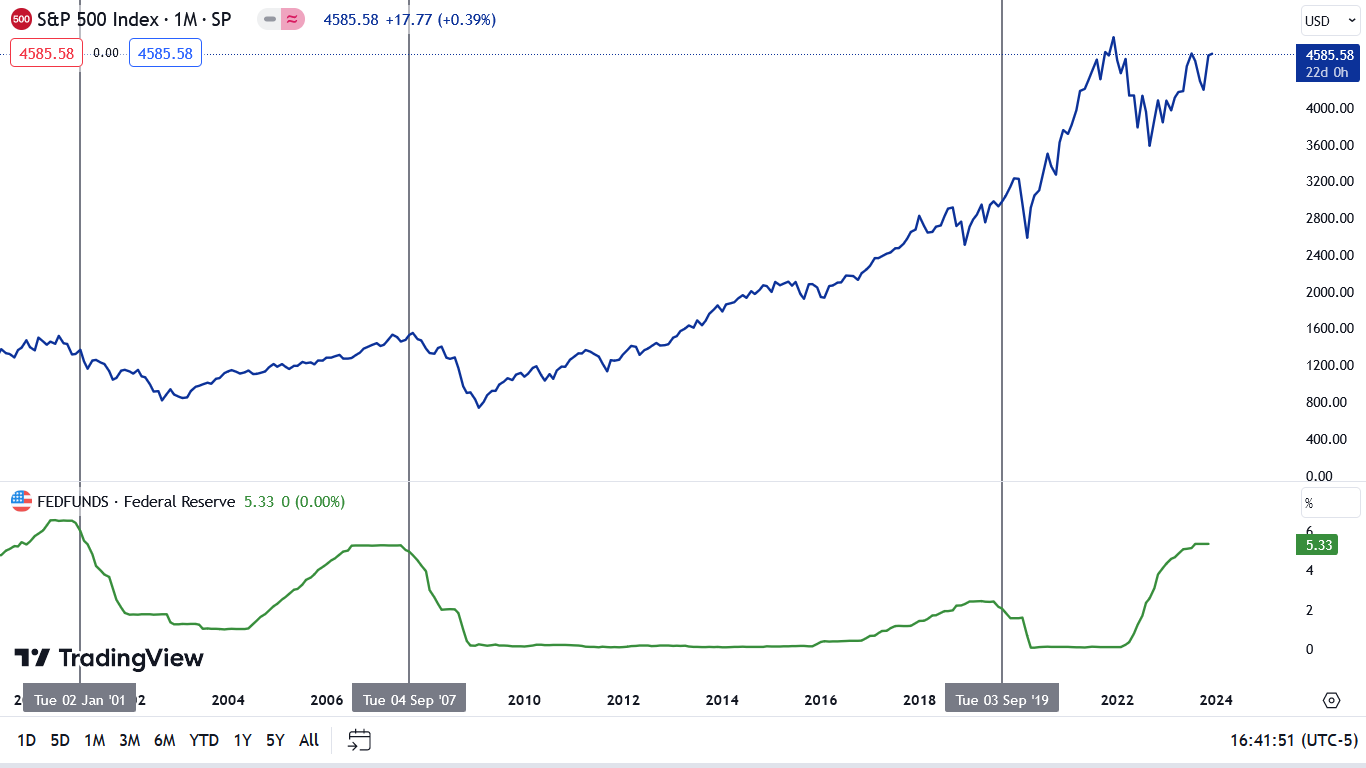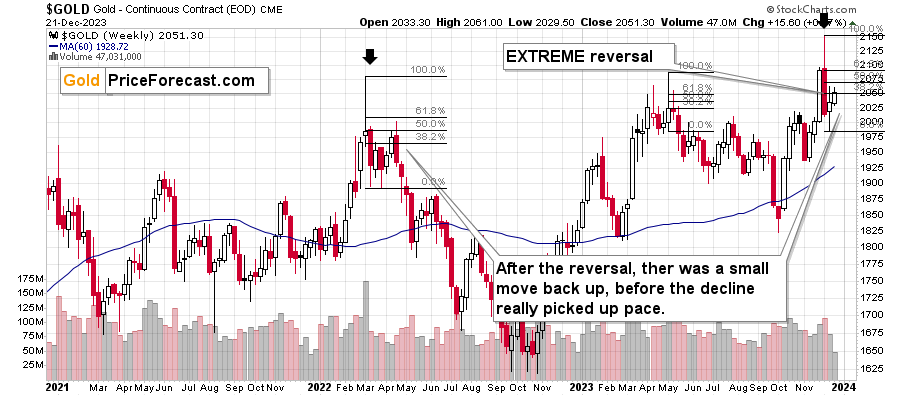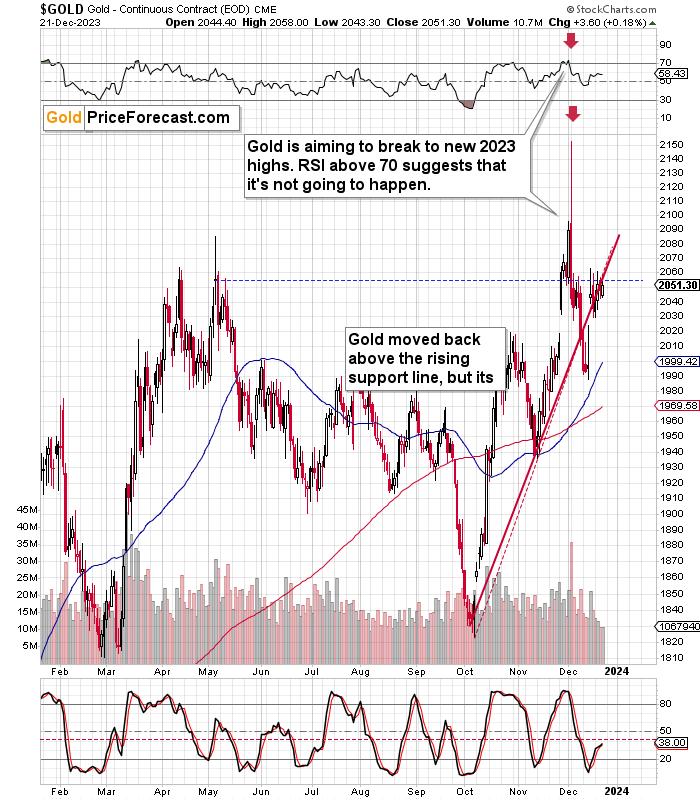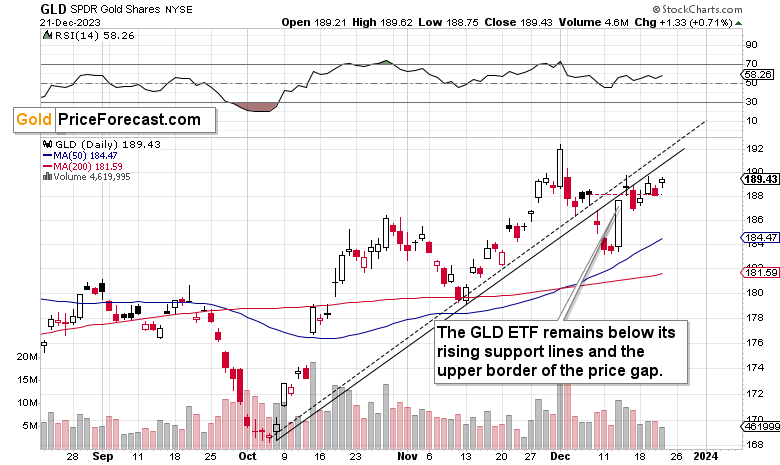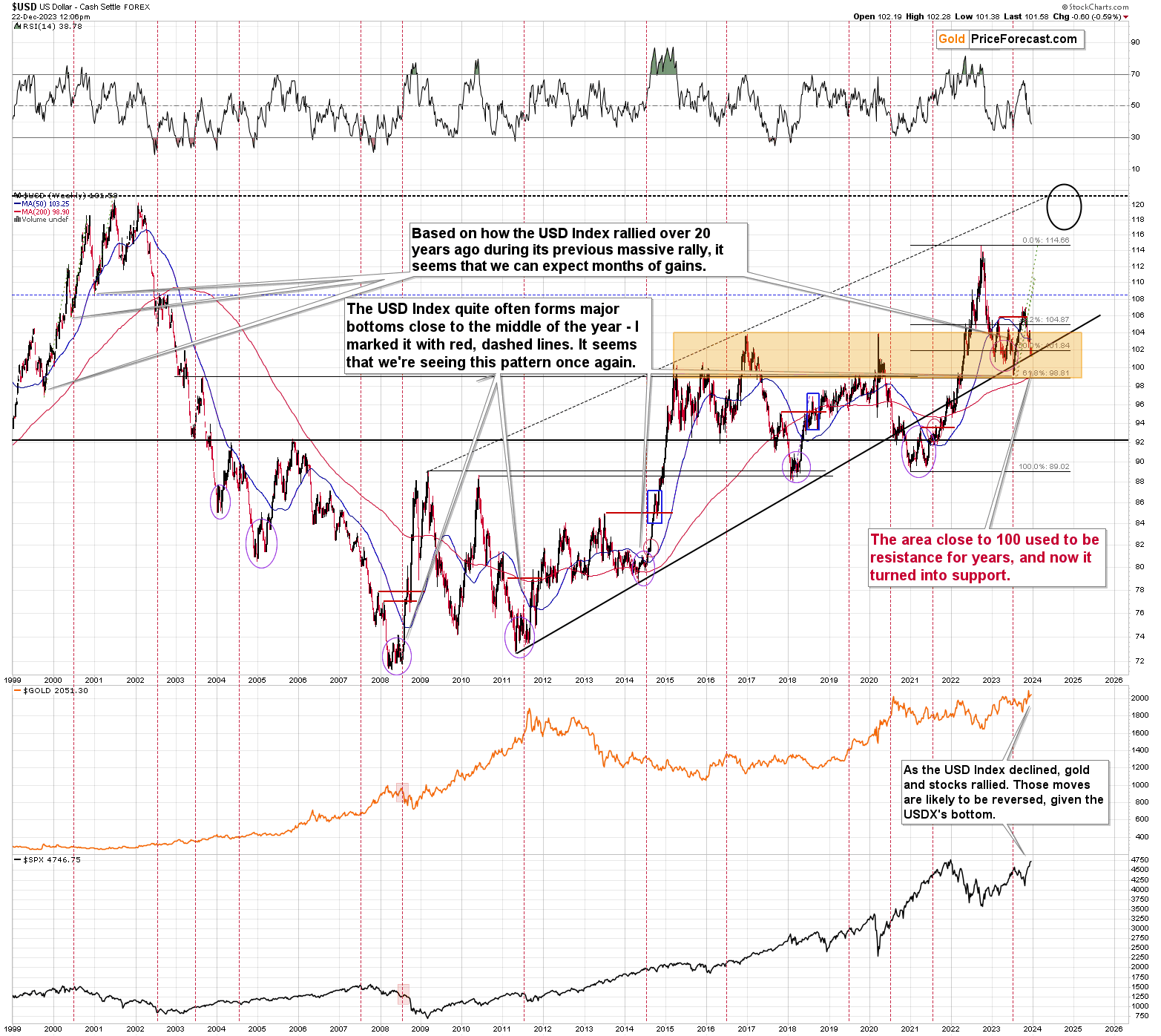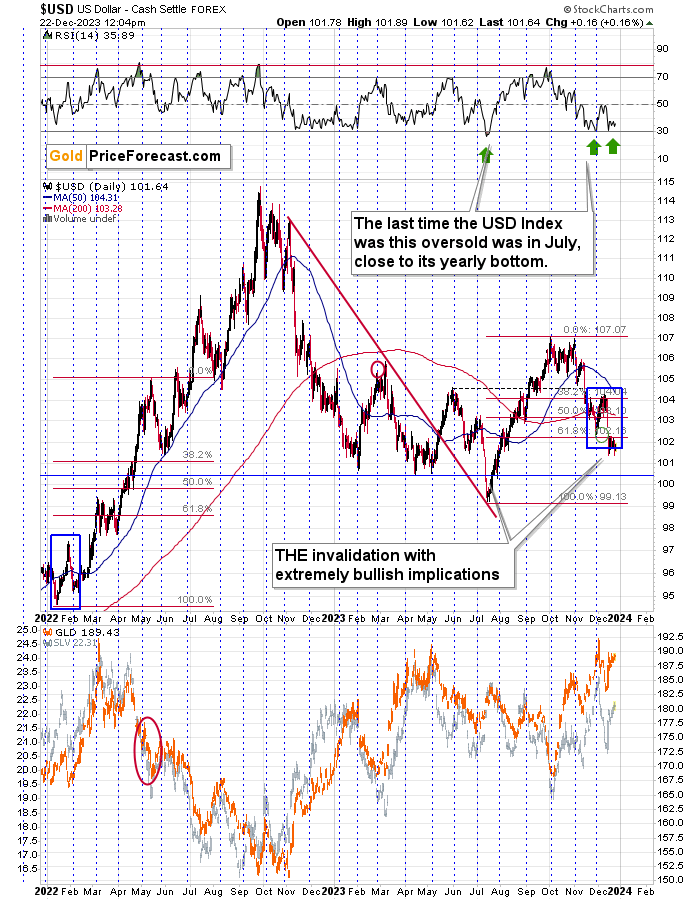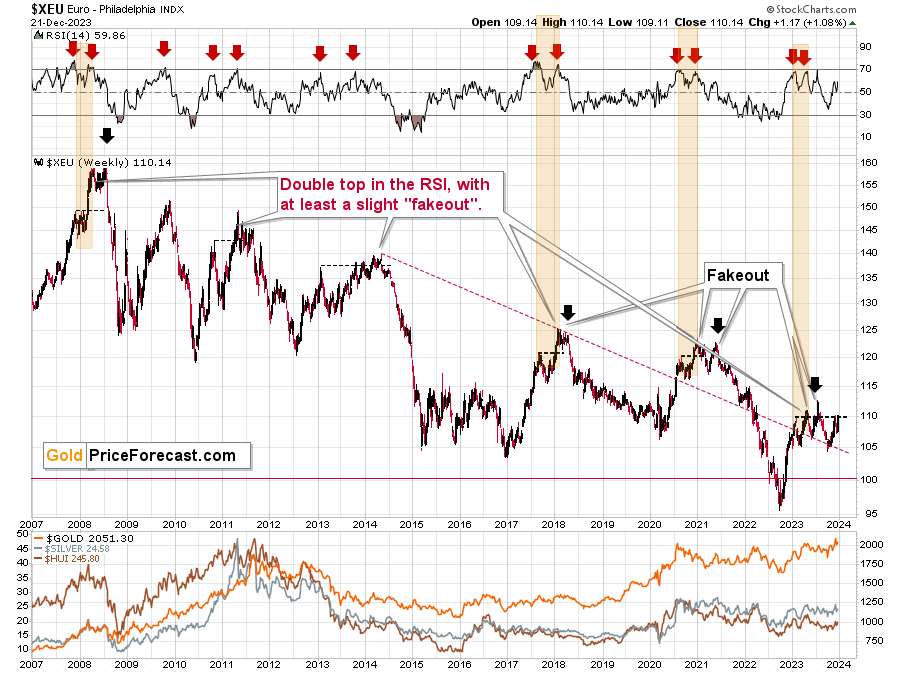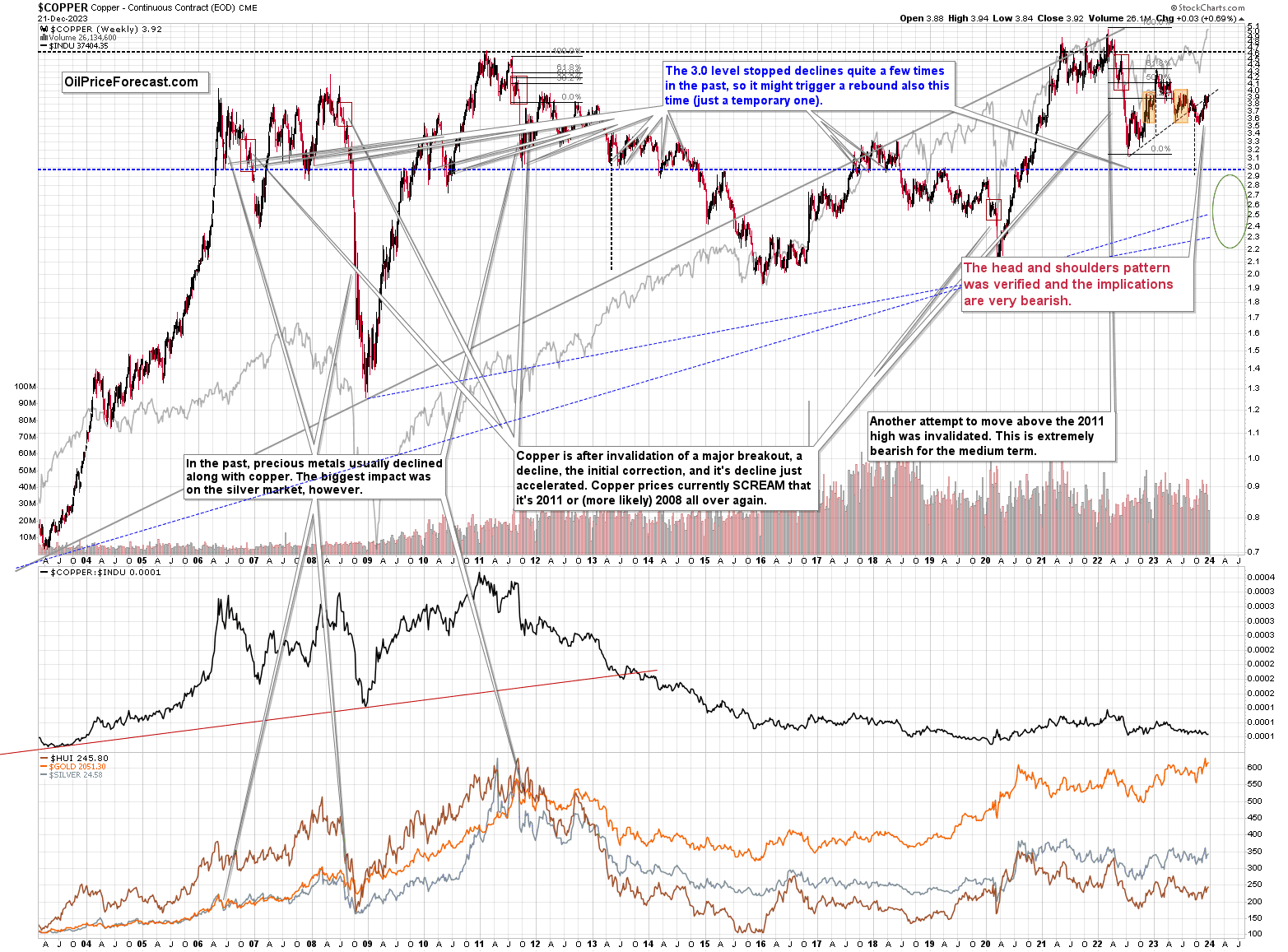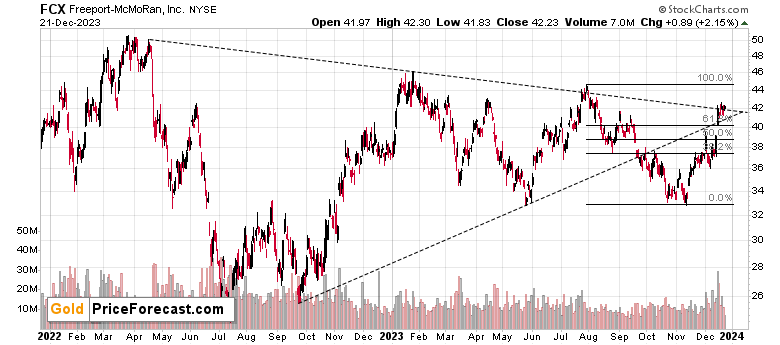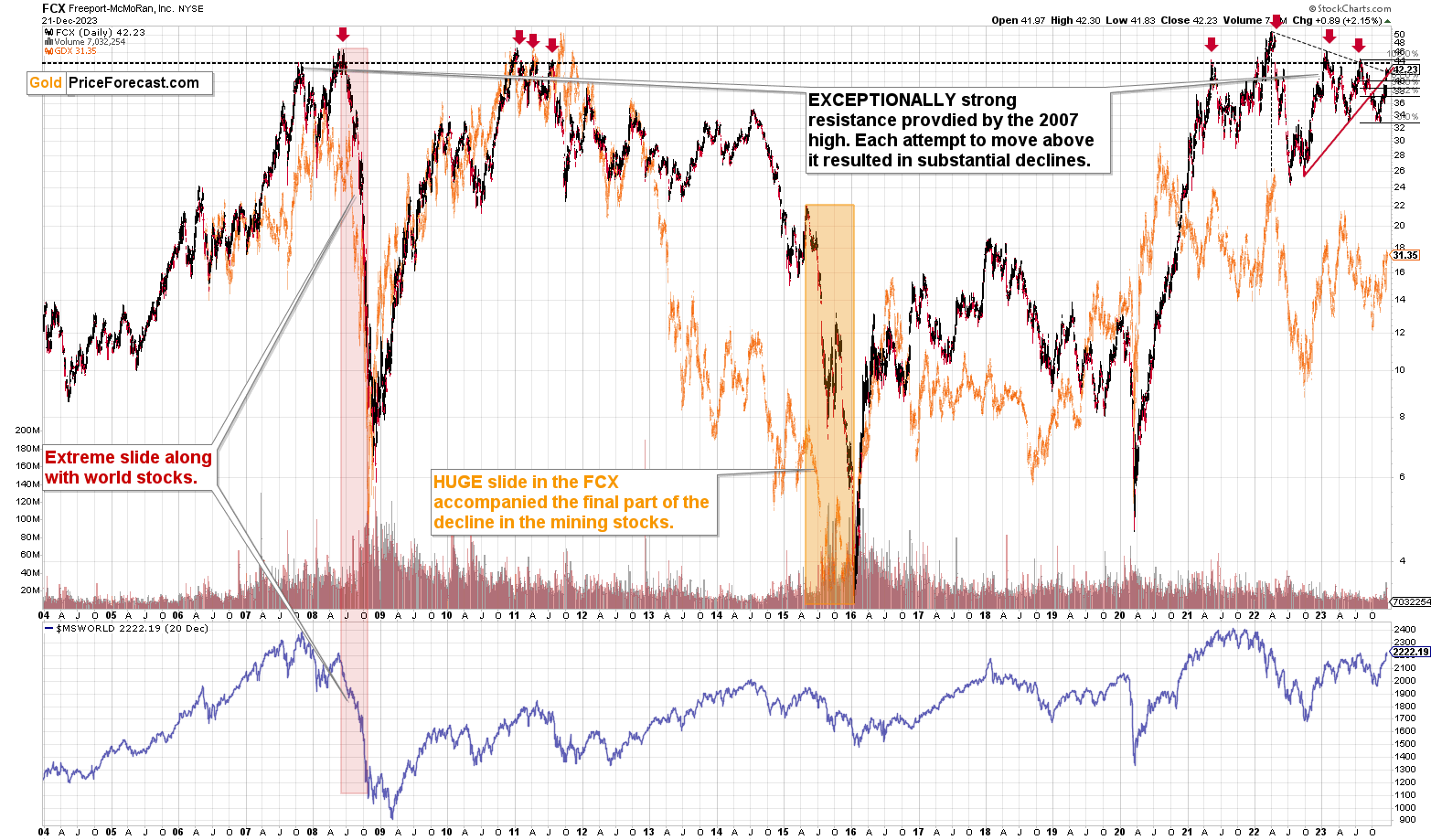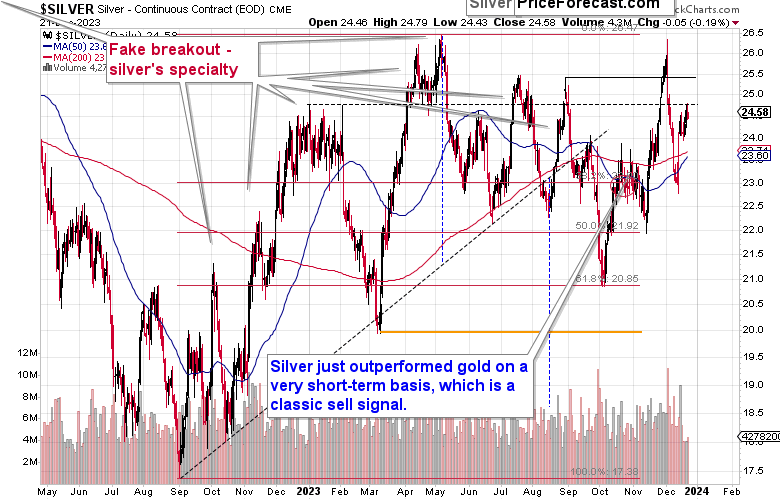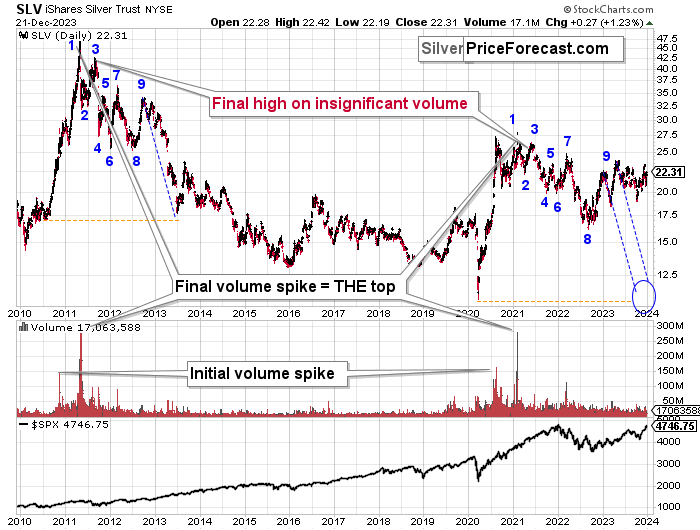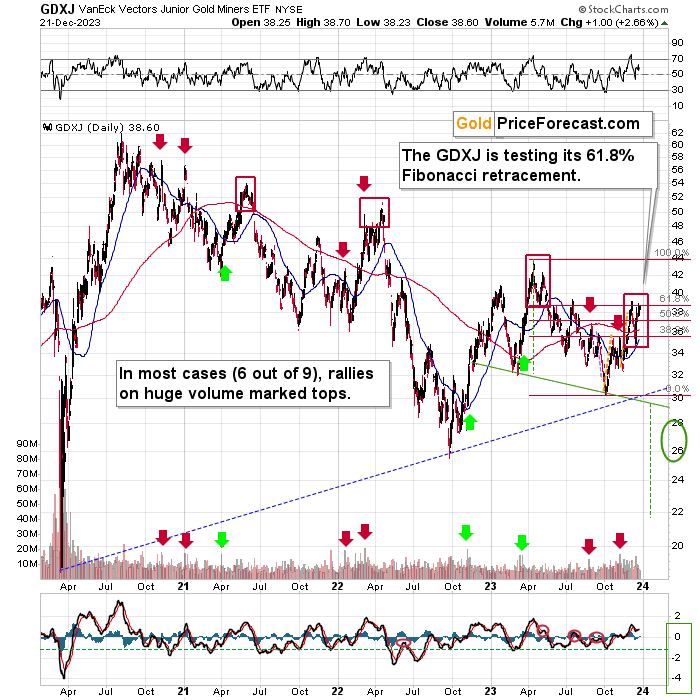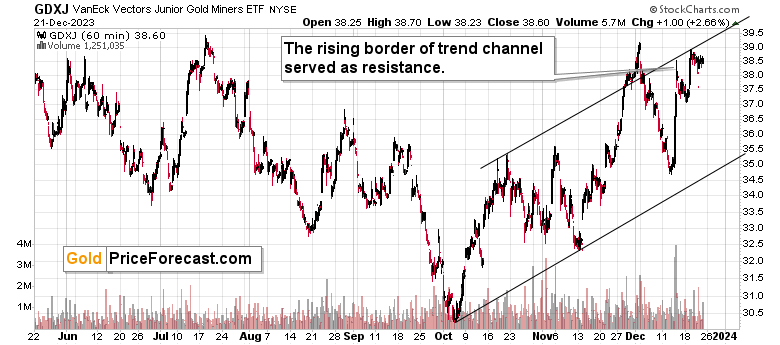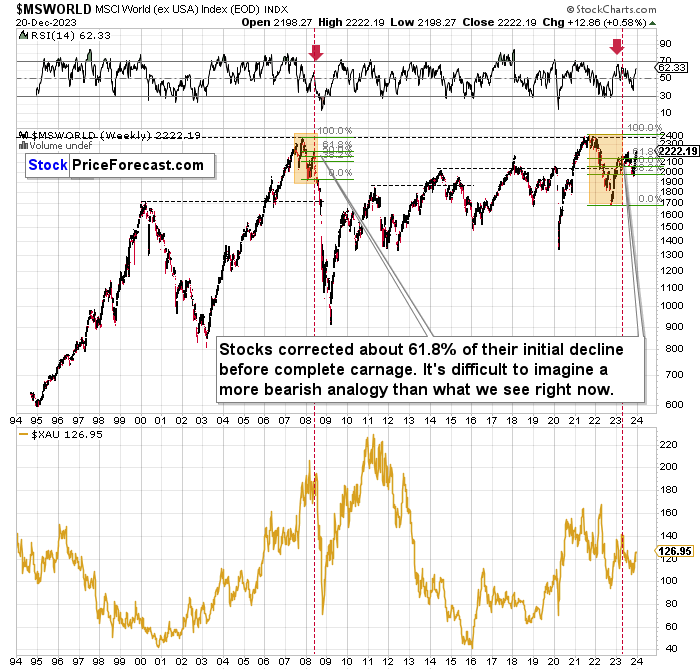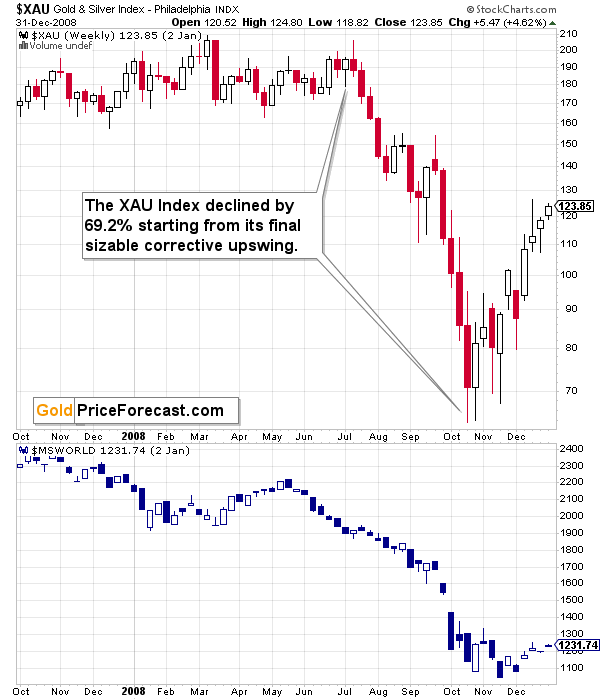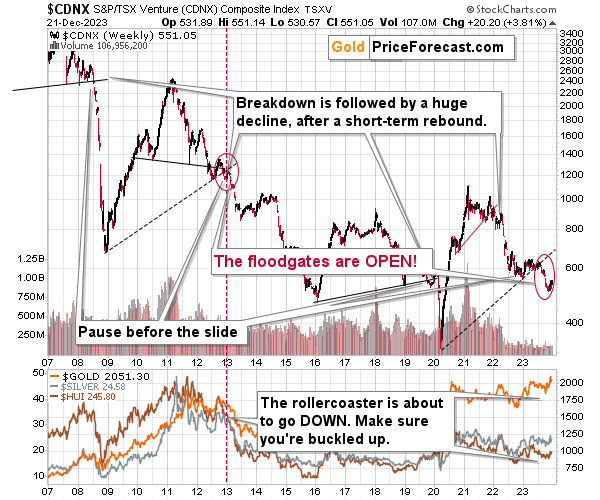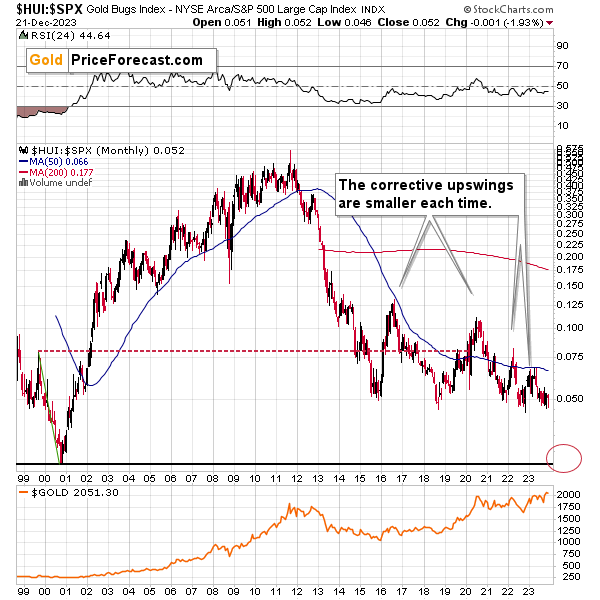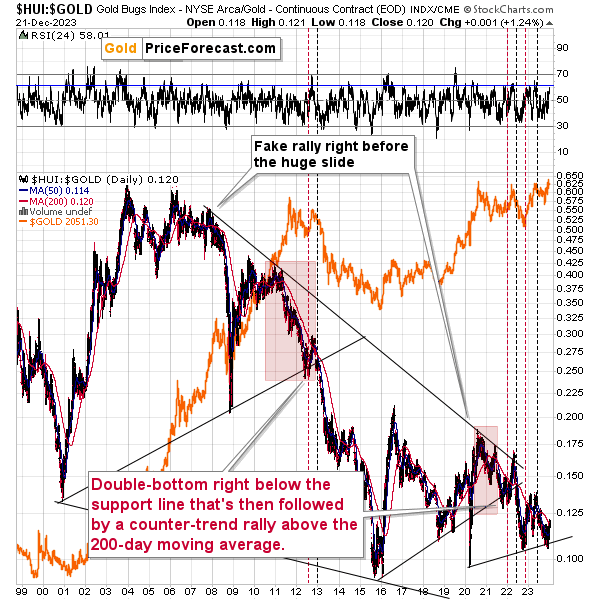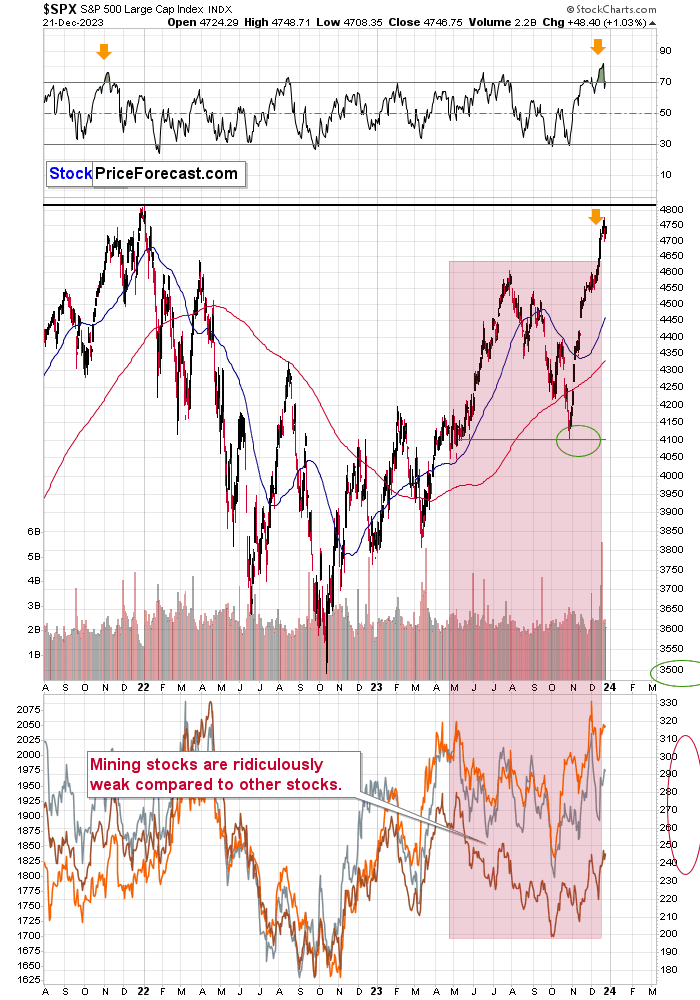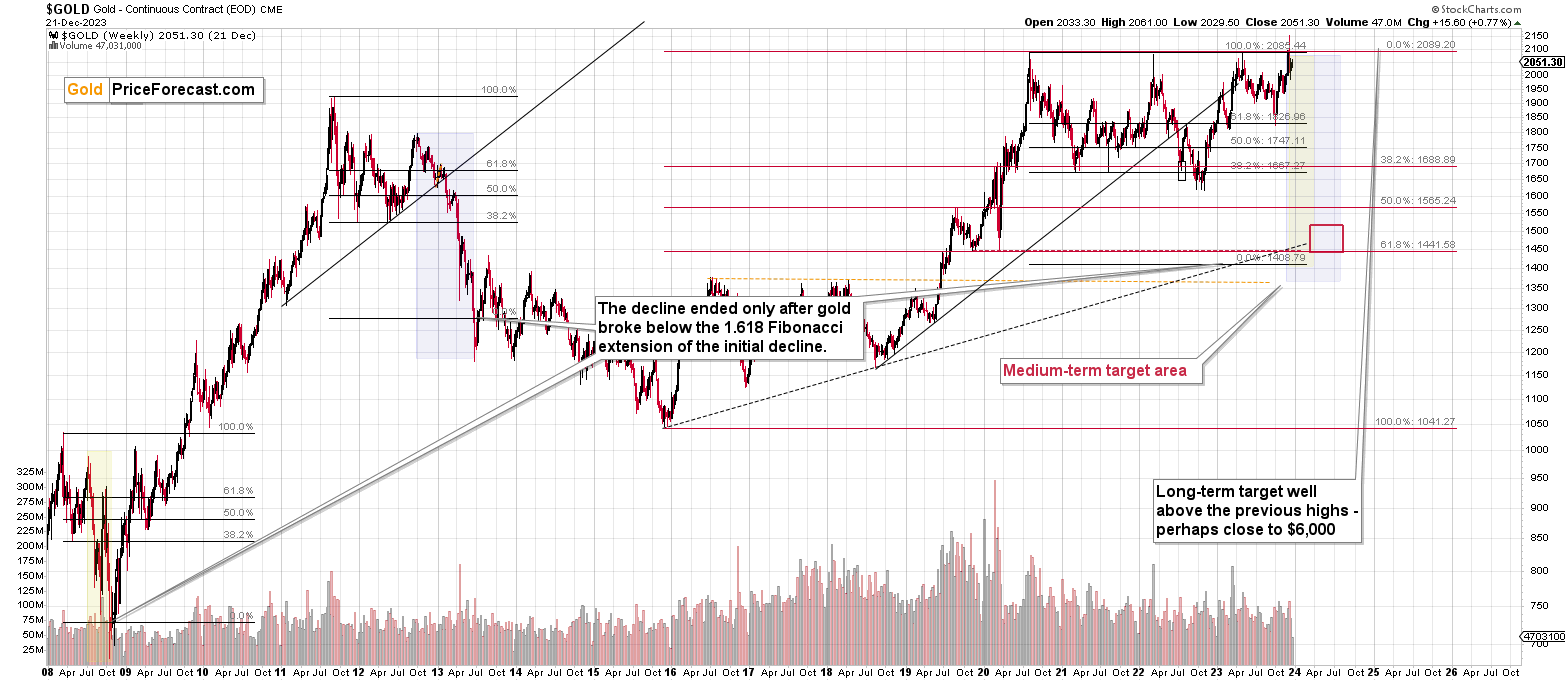Briefly: in our opinion, full (300% of the regular position size) speculative short positions in junior mining stocks (GDXJ) are justified from the risk/reward point of view at the moment of publishing this Alert.
Some might consider an additional (short) position in the FCX.
Welcome to this week's flagship Gold Trading Alert.
Predicated on last week’s price moves, our most recently featured medium-term outlook remains the same as the price moves align with our expectations (and we remain on a streak of 11 realized – unleveraged – trades). On that account, there are parts of the previous analysis that didn’t change at all in the earlier days and are written in italics.
The key event of the recent past is still gold’s profound weekly reversal that we saw two weeks ago, and nothing that happened in the meantime (including today’s pre-market upswing in gold) invalidated the enormously bearish implications thereof. While I realize that it’s most difficult to focus on what really happened instead of following the prevailing feeling (it “feels” most bullish close to the tops), I trust that my analysis will help to keep things in the proper perspective.
The key fundamental development that happened recently is the Fed’s dovish turn, which is I’ll once again start with a quote from the previous analysis about that topic, and I’ll move to the technical details next.
Debunking Rate-Cut Optimism
The recent narrative uplifting stocks and the PMs is the belief that a pivot is bullish. Conversely, pivots are not bullish, and risk assets often crash when they realize why rate cuts are occurring.
Please see below:
To explain, the blue line above tracks the S&P 500, while the green line tracks the federal funds rate (FFR). If you analyze the horizontal gray lines, you can see that the last three times the Fed cut the FFR, the S&P 500 was already sinking or was approaching a cliff.
Therefore, while it may seem like new highs are inevitable for all assets, the recent optimism is more of a ‘buy the rumor, sell the news’ type trade. In other words, investors will likely bail on the S&P 500 and the GDXJ ETF when the Fed actually cuts rates. To that point, with oil prices resuming their crash, it’s a bad look for global growth when crude oil falls below $70.
Overall, the fundamentals continue to unfold as expected, with higher rates weighing heavily on the U.S. economy. And while the ‘bad news is good news’ trade remains intact, history shows it should end with sharp drawdowns of the S&P 500 and the GDXJ ETF, and a meaningful rise in the USD Index.
Later, I added:
Again, the immediate-term reaction is one thing, as people reacted emotionally to more dovish approach. We also saw an immediate-term rally in 2019, but then a decline materialized, anyway.
So, no, the current move higher doesn’t change the outlook. The big move is still likely to be to the downside. I know that it might be difficult to think so while gold jumped over $30, but this really is the case. Remember how difficult it was to doubt gold’s breakout to new highs? On Dec 4, 2023, I wrote that the breakout is likely to be invalidated and followed by a massive slide. I started that day’s analysis with the following sentence:
“During sharp rallies, it’s nearly impossible to convince investors that this move is about to end. And yet, that’s exactly what is likely.”
That was the top.
And this sentence applies also today. The breakdown below the rising support line in gold was not invalidated and the next big move is likely to be to the downside.
Before I move to gold’s breakdown below its rising support line, it’s considered the key event – the weekly reversal.
I previously wrote about some details coming from the broader perspective and some from the immediate-term analysis, and all that remains true. The recent weekly reversal was so huge that its impact on the next weeks really needs to be kept in mind at all times. It’s not likely that a daily price move in any direction (…) would invalidate the implications of the powerful weekly (!) reversal.
In case that massive reversal seems like a distant memory, here’s a reminder of what happened.
Gold soared above $2,100 only to then plunge to almost $2,000, and in happened on huge volume. This was the most profound weekly reversal in years. It was similar to the reversal that we saw in May 2023 and the one from March 2022, and they both started big declines.
The same is likely this time.
This means that this and last weeks moves higher were just a small rebound before the decline’s continuation.
This is particularly likely given the fact that both previous weekly reversals were followed by some kind of bounce before the decline really picked up pace. In 2022, it took several weeks before the second (lower) top formed and in May 2023 the corrective upswing was over within a week. Right now, we’re 1.5 weeks after the reversal, which means that the decline could start any day now.
Also, please note that in 2022, gold corrected over 50% of the initial decline before finishing the rebound, and in May 2023, gold corrected slightly over 61.8% of the initial decline before moving south. This means that the size of the rally that we just saw is nothing extraordinary. In particular, it doesn’t mean that gold rallied so much that it invalidates the immensely bearish implications of the recent weekly reversal.
Now, given today’s pre-market move in gold futures to $2,077 (that’s the overnight high at the moment of writing these words), gold is slightly above the 50% Fibonacci retracement and it’s not close to the 61.8% retracement.
This is in perfect tune with the previous post-massive-reversal-top price patterns, which means that it doesn’t invalidate them. This is a normal behavior after a gargantuan reversal.
This is in perfect tune with the previous post-massive-reversal-top price patterns, which means that it doesn’t invalidate them. This is a normal behavior after a gargantuan reversal.
Yes, I put the same paragraph twice, and I did it in purpose. If there’s one thing that I want you to remember about the current market situation is this. I’m going to continue to describe what’s happening in other markets, but – given the profoundness and importance of the weekly reversal – the above is enough to make the current outlook for gold (and in consequence for silver and mining stocks) bearish for the following weeks (and likely months).
Now, keeping this in mind, let’s take a look at gold’s medium-term chart.
Gold just broke below its rising, red support (which means that it turned into resistance) line in a stealthy manner, and I wrote about it yesterday:
Gold has quietly verified the breakdown below its rising support line!
The breakdown that we saw in the first half of the month was more visible, but it was invalidated within a few days after the move below the line.
This time, gold not only closed below the rising support line for four consecutive days (today is the fifth day below it), but it actually moved back to it and then it declined once again.
This means that gold is more likely to decline now than it was in the first half of December (at least based on the short-term chart alone).
The fact that this breakdown and the subsequent verification were stealthy doesn’t make them any less important.
Here’s how the situation looks like from the GLD ETF point of view:
Gold is relatively far from even the lower of the rising support lines; there was no invalidation of breakdown from this perspective – it’s fully confirmed.
At the moment of writing these words, gold is once again above the above-mentioned support line, but the session is not open yet, let alone closed, which means that the breakout is far from being “real” let alone confirmed. Since the breakdown was already confirmed, we would now need to see a confirmed breakout for the move to have really bullish implications.
And that seems doubtful given what I wrote about gold’s long-term chart (the weekly reversal!).
Yes, I know that I’ve been writing about the weekly reversal multiple times already, but I really want you to keep it in mind. If I gave it just as much attention within the text as to many other signals, many subscribers might think that they are similarly important, and this couldn’t be further from the truth. Just because there are some news releases or signals from some indicators every day, doesn’t make any of them important. And gold price’s weekly reversal is not just an event, it’s THE event.
While the gold price has been correcting (nothing more!) after the profound reversal, the USD Index moved lower, and its even testing its recent lows at the moment of speaking these words.
As gold is not testing it recent highs, gold is not fully reacting to USD’s weakness, which is bearish for the former.
And since the latter is not likely to decline much from here, it seems that gold will get a bearish push from USD’s rebound any day now.
Why wouldn’t the USD Index want to decline from here?
Because it’s at its rising, long-term support line that already stopped this year’s decline. There was a slight breakdown below it, and once that happened, the USD Index rose like Phoenix from the ashes, launching a big, medium-term rally. This is quite likely to happen again.
From the short-term point of view, we see that after a small (but still!) invalidation of the move below the 61.8% Fibonacci retracement, the USDX is making another attempt to move below it. Will it succeed? I doubt it, not just because it already failed once but because of the existence of the long-term support line from the previous chart.
Besides, the USD Index’s biggest component, the EUR/USD, formed a bearish pattern, suggesting a quick reversal.
The European currency moved once again to its early-2023 top, thus likely creating a multi-top pattern. This has been a common way for the EUR/USD to top and I marked the previous cases on the above chart.
In 2008 and in 2011 there were sharp, final comebacks to this level before the decline continued. The one in 2014 was small, but it was still there, and the same goes for the one seen in 2021.
What might see chaotic or a game-changer from the short-term point of view, often becomes normal and orderly when looked at from a bigger perspective.
The situation in copper also confirms that a turnaround is here or just around the corner.
The recent rally was quite sharp, but it took copper back to its rising resistance line, which is also the neck level of the head-and-shoulders formation. A decline from here would be a natural consequence of the verification of the breakdown. The target based on the head-and-shoulders formation is below 3.0, and that’s where copper is likely heading, at least initially.
Naturally, the above would be likely to have a very negative impact on the prices of copper stocks, like FCX.
Right now, FCX moved to its declining resistance line based on the April 2022 and January 2023 highs, so it’s a good point from which it could move lower. And since the move higher was sharp, the move back down could be just as sharp, especially that FCX’s move above the rising resistance line was not confirmed (while the previous breakdown was).
To be precise, the FCX moved slightly above its declining, dashed resistance line, but since by doing so, it topped back in August, the current implications are not bullish.
Since the price target for copper is well below its current price, FCX is likely to fall far from the current levels as well.
The declines from the current levels after failed breakouts above the 2007 high were big, and in some cases (in 2008) they were enormous. The downside potential is waaaay bigger than what you can see on FCX’s short-term chart.
Speaking of breakouts that are not necessarily bullish, let’s take a look at silver.
The white metal recently touched its early 2023 highs, and in today’s pre-market trading it even moved slightly above it (the overnight high is $24.84 at the moment of writing these words).
Many traders would consider a breakout in silver as something very bullish. It would probably be the same “many traders” that get caught by surprise when silver reverses right when it “shouldn’t”. The white metal is behaving very specifically, and it’s a very difficult market for beginning traders.
One of the reasons is silver’s tendency to invalidate breakouts. Each breakout above the early-2023 highs was invalidated and followed by substantial declines. The current tiny attempt to move above it is unlikely to be any different. Consequently, the implications of silver’s overnight move higher are not bullish but bearish.
Besides, please note that the recent back-and-forth movement in silver is similar to what silver did in late 2012 and early 2013.
The final tops (2011, 2021) formed on huge volume, and that was preceded by an initial volume spike. Then the SLV ETF declined in a back-and-forth manner, where we saw 9 bigger highs and lows. Then, after the final (9) top, silver declined in a back-and-forth manner in a smaller range.
We see the same thing right now. The current price movement is what preceded one of the biggest declines in silver’s recent history, so it’s difficult to view the recent performance as something bullish.
The analogy to 2011-2013 had very bearish implications for the following weeks and months, so the implications here are bearish, not bullish.
Gold stocks moved higher yesterday, but they didn’t invalidate either their Wednesday decline, or their similarity to the previous double-top patterns.
I previously wrote the following:
In case of this ETF, the link between big-volume rallies and local tops is not as clear as it is in case of silver, but it’s still present. I marked the similar cases with arrows and in 6 out of 9 such cases, big-volume rallies marked local tops, or those tops followed very soon. Only in 3 out of 9 cases, big rallies followed.
Interestingly, all those three bullish cases were preceded by declines that were much bigger than what we saw recently. This suggests that the bullish analogies are not the correct ones. The bearish ones are.
What’s next? While the next 1-3 days are a bit unclear, the entire roadmap that I featured for the GDXJ ETF in my previous Gold Trading Alert remains very much up-to-date.
The markets usually don’t move up or down in a straight line, so some kind of correction is likely to take place in the future, anyway. The question is from what price levels.
My best candidate for the first correction (based on the data that I have available right now) is The $30.5 - $32 range, which is based on the previous lows. I don’t expect a huge rally from those levels, though. Perhaps a move from $30.5 to $32, and then the decline would continue.
The next target is more important. After breaking to new 2023 lows, the move to the 2022 low (close to $26) becomes a good possibility – I marked this area with a green ellipse.
Once this level is reached, I then expect the GDXJ to correct in a more visible manner. After all, at that point, it will be after important breakdowns:
- Below the rising blue support line
- Below the previous 2023 low
- Below the green support line
Consequently, a verification of those breakdowns by a move back to them, would be quite normal. This means a move back to $29 - $30. Then, after a successful verification of those breakdowns, I’d expect the GDXJ to slide lower – to the 2020 low or close to them – at about $20.
There’s also a good possibility of seeing a bottom at about $22, as that’s where we have a downside target based on the head-and-shoulders pattern that is most likely being formed right now. It could also be the case that the GDXJ slides to about $20 on an intraday basis only to recover and close the day at about $22. In a way, both targets would be reached in this case.
There are many IFs around the above-mentioned scenario, and the situation might (and it probably will) change as we go. Remaining open-minded and flexible regarding the new information is key, but having a roadmap is very useful, too, as it shows how things could develop on a more-or-less basis. This can help you prepare for those – or similar – price moves.
The GDXJ is currently testing its 61.8% Fibonacci retracement based on the recent decline – this is a normal thing for a market to do. No market moves up or down in a straight line (ok, miners and silver declined almost without looking back in 2008 and 2020), and Fibonacci retracements are useful when determining how big a given correction might be. Being at or below the retracement means that there’s no change in the previous – bearish – trend.
Looking at the GDXJ from a very short-term point of view, we see another reason for its price to move lower.
The upper border of the trend channel was reached (twice) and the GDXJ reversed from there (twice).
Based on the above chart alone, we’re likely to see a move lower, quite likely to $35 or so. However, based on many other charts, it’s likely that the move to $35 will be just the first step in a way to much lower levels.
After all, the indications from short-term charts are less important than ones from medium-term charts, which in turn are less important than ones from long-term charts.
Now, given today’s overnight move higher in gold, it’s quite possible that we’ll see another attempt to move higher, perhaps even a move to the July high at about $39.5. However, just like the early-December rally was followed by a sizable decline, this attempt is likely to be followed by declines as well.
The market is likely to turn south any day now (why? Please recall gold’s weekly reversal), so any strength here is likely to be invalidated.
Meanwhile, the implications coming from many long-term charts continue to favor lower precious metals and mining stock prices in the following months.
For example, the situation in world stocks hasn’t really improved recently.
The situation continues to be very similar to what we saw in 2008, with the main difference being that now the initial decline was bigger. Because of that it’s no wonder that the corrective upswing is also bigger and it takes longer.
In both cases, world stocks corrected to approximately the 61.8% Fibonacci retracement, and they declined thereafter. This time, there were two corrections to that level, which is not that odd given that the initial decline was bigger this time.
The implications remain very bearish not just for stocks, but also for mining stocks.
As you can see miners (the XAU Index) suffered enormously in 2008 in the aftermath of the situation that’s so similar to the current one. Let’s take a closer look.
This analogy has very bearish implications for the following months.
And while we’re discussing stock market indices and their long-term charts, let’s not forget about the critical situation in the Toronto Stock Exchange Venture Index – one of the proxies for junior mining stocks.
The TSXV is after a massive breakdown below the rising support line, that’s analogous to the one that we saw in early 2013 – and, to a smaller extent, to the one seen in 2008.
Now we see a pause in the decline, but given that the breakdown was already confirmed, the decline is likely to resume after the pause, and it’s likely to put a very bearish pressure on the precious metals and mining stock prices.
Gold stocks to other stocks also clearly show how important and big the recent “strength” in the mining stocks was.
In short, both are nonexistent. The ratio between the HUI Index (a proxy for gold stocks) and the S&P 500 Index (general stock market) is testing its recent lows.
It takes just a little push for the ratio to break below its 2-15, 2018, 2021, and 2022 lows. This is very bearish, because after that breakdown, there’s no significant support all the way down to the 2000 low close to 0.025. This means cutting gold stocks’ prices in half IF the general stock market stays at its current levels, and it means even bigger declines in gold stocks, if other stocks do decline.
Comparing gold stocks to gold reveals we saw another small correction within a long-term downtrend. Ever since mid-2021, all attempts to break above the 200-day moving average (marked with red) were followed by invalidations and declines in the precious metals sector.
This is bearish, and the same goes for the fact that corrective upswings were smaller each time when the ratio moved from about 0.1. The 2016 bottom was followed by a sizable correction, the one from 2020 was smaller than the one that we saw in 2022 was even smaller, and this year’s correction is tiny in comparison.
The implications for the following months are very bearish, as when the ratio finally breaks below the rising support line, it’s likely to decline much lower – as low as the 2016 low or even lower.
Meanwhile, the stock market is approaching its all-time high, and while Paul Rejczak remains cautiously bullish, he’s preparing to exit his long position, and I agree that stocks look very toppy here. My yesterday’s comments on that market remain up-to-date:
The RSI based on the S&P 500 Index was just extremely overbought – more so than at the 2022 top. Given yesterday’s decline close to the end of the session it seems quite possible that the top is in. And if it’s not, it’s likely that the top is at hand anyway, as the all-time high is unlikely to be taken out given this kind of overbought status of the market.
There are some fake rallies out there in individual stocks as well, including individual oil stocks (and here’s today’s example). This could be viewed as another indication that the entire market is about to turn south.
What does it all mean? It means that the precious metals sector is likely to turn south any day now as… That’s right, you guessed it – the ultra-powerful weekly reversal in gold continues to have a very bearish impact on the outlook for gold.
Again, as always, I’ll keep you – my subscribers – updated.
= = =
If you’d like to become a partner/investor in Golden Meadow, you’ll find more details in the above link.
Overview of the Upcoming Part of the Decline
- It seems that the recent – and probably final – corrective upswing in the precious metals sector is over.
- If we see a situation where miners slide in a meaningful and volatile way while silver doesn’t (it just declines moderately), I plan to – once again – switch from short positions in miners to short positions in silver. At this time, it’s too early to say at what price levels this could take place and if we get this kind of opportunity at all.
- I plan to switch from the short positions in junior mining stocks or silver (whichever I’ll have at that moment) to long positions in junior mining stocks when gold / mining stocks move to their 2020 lows (approximately). While I’m probably not going to write about it at this stage yet, this is when some investors might consider getting back in with their long-term investing capital (or perhaps 1/3 or 1/2 thereof).
- I plan to return to short positions in junior mining stocks after a rebound – and the rebound could take gold from about $1,450 to about $1,550, and it could take the GDXJ from about $20 to about $24. In other words, I’m currently planning to go long when GDXJ is close to $20 (which might take place when gold is close to $1,450), and I’m planning to exit this long position and re-enter the short position once we see a corrective rally to $24 in the GDXJ (which might take place when gold is close to $1,550).
- I plan to exit all remaining short positions once gold shows substantial strength relative to the USD Index while the latter is still rallying. This may be the case with gold prices close to $1,400 and GDXJ close to $15 . This moment (when gold performs very strongly against the rallying USD and miners are strong relative to gold after its substantial decline) is likely to be the best entry point for long-term investments, in my view. This can also happen with gold close to $1,400, but at the moment it’s too early to say with certainty.
- The above is based on the information available today, and it might change in the following days/weeks.
You will find my general overview of the outlook for gold on the chart below:
Please note that the above timing details are relatively broad and “for general overview only” – so that you know more or less what I think and how volatile I think the moves are likely to be – on an approximate basis. These time targets are not binding nor clear enough for me to think that they should be used for purchasing options, warrants, or similar instruments.
Letters to the Editor
Depending on the nature and target group of your question, feedback or comment, please use the following means of communication:
- For questions or comments that you’d like to get the Community’s response, please use the Ask the Community space so others can contribute to the reply and also enjoy the answers.
- For questions, comments or feedback that you’d like me to comment on / reply to, please send them to Golden Meadow’s support – some clarifications can be provided directly by our experienced support team, and those that are strictly for me, will be forwarded to me and I’ll then provide replies either individually, or in the “Letters to the Editor” section in the Alerts, depending on the nature of the question/comment.
Summary
To summarize, the key thing about the precious metals market is still gold’s extremely important weekly reversal that we saw two weeks ago, which puts the recent (even today’s) rallies in the proper context. What we see now is a perfectly normal post-initial-decline rebound. These moves used to take gold back up to the 50% - 61.8% (approximately) retracements based on the initial size of the decline, and given today’s upswing, gold futures are now a bit above the 50% retracement. Again, this is normal.
The junior mining stocks are testing their July high, and they are unlikely to break above them in a sustainable manner. Due to the above-mentioned reversal in gold, any strength in the miners here is likely to be invalidated soon.
I know it “feels” extremely bullish, very close to the tops, so it’s particularly difficult to remain calm and objective, but that’s also profitable in the long run. I hope and trust that you will find my analyses helpful in reaching those goals – and growing your portfolio over time (while it’s not possible to have all the short-term moves in the “right” direction, the right approach, help to make money over time).
This completes today’s Gold Trading Alert. It’s also the final Gold Trading Alert before the Holiday weekend, and the next regular Gold Trading Alert is going to be posted on Tuesday. When the markets are volatile, it’s important to keep in mind the proper perspective. When things are volatile in general, the same rule applies.
May the time spent with your loved ones fill your hearts with peace and joy and put everything that’s going on in your lives into proper perspective. On behalf of the entire Golden Meadow, I wish you to experience an immense amount of joy and love in the following days. Happy Holidays! :)
===
As we’re on a streak of 11 profitable (closed, unleveraged) trades, and – just like I wrote today and in the previous days – it looks like we’re going to see much more of them in the near future, I want to provide you with even more great news!
We’re opening the possibility to extend your subscription for up to three years (at least by one year) with a 10% discount from the current prices.
Locking in those is a great idea not only because it’s perfect time to be ready for what’s next in the precious metals market, but also because the inflation might persist longer than expected and prices of everything (including our subscriptions) are going to go up in the future as well. Please reach out to our support – they will be happy to assist you and make sure that your subscription days are properly extended at those promotional terms. So, for how many years would you like to lock-in your subscription?
This 10% discount (and ability to subscribe to up to three years) applies also in case of the just-released Diamond Package that includes not only Gold Trading Alerts, but also Oil Trading Alerts and Stock Trading Alerts. This package provides access with an additional (bundle-offer) discount, and it’s the most prestigious product that we have in our offer. Be sure to use the “DIAMOND10” code when going Diamond for the 10% discount.
To summarize:
Trading capital (supplementary part of the portfolio; our opinion): Full speculative short positions (300% of the full position) in junior mining stocks are justified from the risk to reward point of view with the following binding exit profit-take price levels:
Mining stocks (price levels for the GDXJ ETF): binding profit-take exit price: $28.12; stop-loss: none.
Alternatively, if one seeks leverage, we’re providing the binding profit-take levels for the JDST (2x leveraged). The binding exit level for the JDST: $10.54; stop-loss for the JDST: none.
For-your-information targets (our opinion; we continue to think that mining stocks are the preferred way of taking advantage of the upcoming price move, but if for whatever reason one wants / has to use silver or gold for this trade, we are providing the details anyway.):
Silver futures downside exit price: $20.22 (stop-loss: none)
SLV exit price: $18.62 (stop-loss: none)
ZSL exit price: $24.98 (stop-loss: none)
Gold futures downside exit price: $1,812 (stop-loss: none)
Spot gold downside exit price: $1,792 (stop-loss: none)
HGD.TO – alternative (Canadian) 2x inverse leveraged gold stocks ETF – the exit price: $8.43 (stop-loss: none)
HZD.TO – alternative (Canadian) 2x inverse leveraged silver ETF – the exit price: $19.49 (stop-loss: none)
///
Optional / additional trade idea that I think is justified from the risk to reward point of view:
Short position in the FCX with $27.13 as the short-term profit-take level.
Long-term capital (core part of the portfolio; our opinion): No positions (in other words: cash)
Insurance capital (core part of the portfolio; our opinion): Full position
Whether you’ve already subscribed or not, we encourage you to find out how to make the most of our alerts and read our replies to the most common alert-and-gold-trading-related-questions.
Please note that we describe the situation for the day that the alert is posted in the trading section. In other words, if we are writing about a speculative position, it means that it is up-to-date on the day it was posted. We are also featuring the initial target prices to decide whether keeping a position on a given day is in tune with your approach (some moves are too small for medium-term traders, and some might appear too big for day-traders).
Additionally, you might want to read why our stop-loss orders are usually relatively far from the current price.
Please note that a full position doesn't mean using all of the capital for a given trade. You will find details on our thoughts on gold portfolio structuring in the Key Insights section on our website.
As a reminder - "initial target price" means exactly that - an "initial" one. It's not a price level at which we suggest closing positions. If this becomes the case (as it did in the previous trade), we will refer to these levels as levels of exit orders (exactly as we've done previously). Stop-loss levels, however, are naturally not "initial", but something that, in our opinion, might be entered as an order.
Since it is impossible to synchronize target prices and stop-loss levels for all the ETFs and ETNs with the main markets that we provide these levels for (gold, silver and mining stocks - the GDX ETF), the stop-loss levels and target prices for other ETNs and ETF (among other: UGL, GLL, AGQ, ZSL, NUGT, DUST, JNUG, JDST) are provided as supplementary, and not as "final". This means that if a stop-loss or a target level is reached for any of the "additional instruments" (GLL for instance), but not for the "main instrument" (gold in this case), we will view positions in both gold and GLL as still open and the stop-loss for GLL would have to be moved lower. On the other hand, if gold moves to a stop-loss level but GLL doesn't, then we will view both positions (in gold and GLL) as closed. In other words, since it's not possible to be 100% certain that each related instrument moves to a given level when the underlying instrument does, we can't provide levels that would be binding. The levels that we do provide are our best estimate of the levels that will correspond to the levels in the underlying assets, but it will be the underlying assets that one will need to focus on regarding the signs pointing to closing a given position or keeping it open. We might adjust the levels in the "additional instruments" without adjusting the levels in the "main instruments", which will simply mean that we have improved our estimation of these levels, not that we changed our outlook on the markets. We are already working on a tool that would update these levels daily for the most popular ETFs, ETNs and individual mining stocks.
Our preferred ways to invest in and to trade gold along with the reasoning can be found in the how to buy gold section. Furthermore, our preferred ETFs and ETNs can be found in our Gold & Silver ETF Ranking.
As a reminder, Gold & Silver Trading Alerts are posted before or on each trading day (we usually post them before the opening bell, but we don't promise doing that each day). If there's anything urgent, we will send you an additional small alert before posting the main one.
===
On a side note, while commenting on analyses, please keep the Pillars of the Community in mind. It’s great to provide points that help others be more objective. However, it’s important to focus on the facts and discuss them in a dignified manner. There is not much of the latter in personal attacks. As more and more people join our community, it is important to keep it friendly. Being yourself, even to the point of swearing, is great, but the point is not to belittle other people or put them in a position of “shame” (whether it works or not). Everyone can make mistakes, and everyone does, in fact, make mistakes. We all here have the same goal: to have a greater understanding of the markets and pick better risk-to-reward situations for our trades. We are on the same side.
On another – and final – side note, the number of messages, comments etc. that I’m receiving is enormous, and while I’m grateful for such engagement and feedback, I’m also starting to realize that there’s no way in which I’m going to be able to provide replies to everyone that I would like to, while keeping any sort of work-life balance and sanity ;) Not to mention peace of mind and calmness required to approach the markets with maximum objectivity and to provide you with the service of the highest quality – and best of my abilities.
Consequently, please keep in mind that I will not be able to react / reply to all messages. It will be my priority to reply to messages/comments that adhere to the Pillars of the Community (I wrote them, by the way) and are based on kindness, compassion and on helping others grow themselves and their capital in the most objective manner possible (and to messages that are supportive in general). I noticed that whatever one puts their attention to – grows, and that’s what I think all communities need more of.
Sometimes, Golden Meadow’s support team forwards me a message from someone, who assumed that I might not be able to see a message on Golden Meadow, but that I would notice it in my e-mail account. However, since it’s the point here to create a supportive community, I will specifically not be providing any replies over email, and I will be providing them over here (to the extent time permits). Everyone’s best option is to communicate here, on Golden Meadow, ideally not in private messages (there are exceptions, of course!) but in specific spaces or below articles, because even if I’m not able to reply, the odds are that there will be someone else with insights on a given matter that might provide helpful details. And since we are all on the same side (aiming to grow ourselves and our capital), a ton of value can be created through this kind of collaboration :).
Thank you.
Przemyslaw K. Radomski, CFA
Founder, Editor-in-chief


